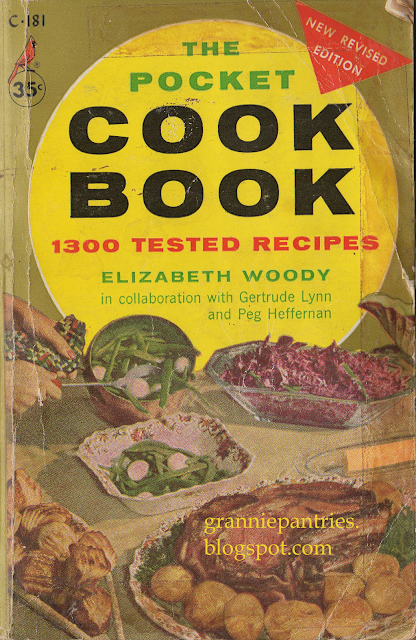The Pocket Cook Book (Elizabeth Woody with Gertrude Lynn and Peg Heffernan, originally published in 1942, but mine is the 1960 edition) is one of those old paperbacks that could, as advertised, fit in your pocket (as long as your pockets were relatively substantial).
My main takeaway from the cover is that whoever created it never worried about washing dishes. (I am not from a "put it in a serving bowl so it will look nice" family. We were firmly of the "serve it out of the cooking container" camp. Besides saving on dishes, it also keeps food warm longer. Double win!)
This little book offers a lot of fairly standard meats, sides, and desserts, but there are a few surprises along the way, so I'm cooking up a menu of mayhem.
First, we need an appetizer. When I saw a recipe for Devilled Cheese Rolls, I assumed it would be for some type of lightly spiced cheese rolled in a slice of white bread with the crusts trimmed off or maybe spread on a slab of biscuit dough which would subsequently be rolled up, sliced into individual servings, and baked. I was wrong.
The vessel for the devilled cheese is not bready at all, but instead, sliced tongue! Definitely not something I would expect in an appetizer...
I couldn't decide for the main course, so you've got two choices. If you really love shortcake, maybe you'd want it as a main course?
You've got to have a high tolerance for Vienna sausages, though. Not sure the corn and white sauce will be enough to cover up their flavor....
If you want to go higher-end, there's Chicken Hawaiian.
I expected the pineapple, of course, but this also includes ham (a little reminiscent of Hawaiian pizza) and avocado... So if you don't want to have to take out a loan for a recipe that will probably disappoint you anyway, the Vienna Sausage Shortcake might be the way to go.
Now, we need some vegetables, of course. I adore roasted Brussels sprouts, so I wanted to see what Brussels Sprouts Pierre might entail.
While they're not anything too shocking-- just Brussels sprouts and celery in a cheese sauce-- I was not aware people could (or would even want to) buy canned Brussels sprouts or canned celery. Or maybe they were expected to can those at home? Either way-- it sounds like a waste of money (and possibly time if you had to can them yourself).
And finally, we need a dessert. This is not a health food cookbook, so I was a little surprised to see this recipe in the chapter on cookies.
I would not be surprised at all to see Bran Brownies in a late '60s/ early '70s "health food" book, but here they are in a basic, mainstream cookbook. At least they're made with chocolate and not carob!
I'm not convinced any of these recipes are worth dirtying up even one dish for-- much less various serving bowls and platters-- but maybe they would need the help of a pretty presentation. The cover may be on to something....
































